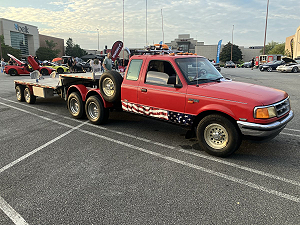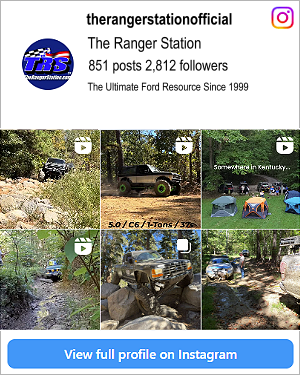PanamaExpat
Well-Known Member
- Joined
- May 28, 2011
- Messages
- 1,076
- Reaction score
- 13
- Location
- Panama City, Rep. of Panama
- Vehicle Year
- 1994
- Make / Model
- Mazda
- Engine Size
- 4 liter
- Transmission
- Manual
Since I don't know how to add anything to the tech library I'll just do up a tread on this and if the mods decide it is worthy they can edit and put it there.
I have read several threads regarding changing the rear oil seal on the V6 engine. I recall one guy remarking that if it isn't leaking don't change it because it will when you are done. That simply isn't the case and I would like to say that if you have gone to all the trouble of pulling out the transmission to change the clutch or perform some other service you might as well go ahead and put in a new rear seal while you are at it. Remember anything made of neoprene that is 15 to 20 years old and has been subjected to heating, cooling, and whatever over the years is going to be worn and brittle. It will take you longer to fabricate up the seal press that it will take to change the seal. But once you have the press all your buddies will ask to borrow it.
Step 1: Making the tool.
Head to your scrap metal pile. Look about for a piece of 2.5 inch ID steel pipe. Get out your chop saw and make certain it is set to cut at a 0 degree angle. Now make 2 cuts. The first is to square off the tubing and the second is to cut the length you need.



Next I took an old piece of 1/16" galvanized that was laying around and popped two 7/16" holes in it 43 mm center to center. I got the 43 mm measurement by measuring across 2 opposing holes on my flywheel. Then as the piece of donor steel was a piece of heavy steel stud I clamped it in the vice and set the piece of tubing centered over the holes and proceeded to zip around it with the fire hatchet (cutting torch). Switched torch tips and grabbed an old coat hanger and proceeded to braze the plate on to the tubing. flipped it over and tacked four more braze spots inside then cleaned it up with the angle grinder and it ends up looking like this.


So now you have the necessary tool. I know a lot of you on here will say just to knock it in with a hammer and a screwdriver but trust me on this particular seal that is NOT a good idea. It HAS to be in straight and not bent or dented or you WILL have an oil leak.
Step 2: Remove old seal
No photo on this but it is a simple maneuver and you shouldn't need one. Tools required: 3/4" to 1 1/4" fine point drywall screw, claw hammer, and number 2 Phillips screwdriver.
On the old seal pick a nice spot midway between the crank and the engine block. Set the tip of the drywall screw there and tap lightly with hammer to pierce a small hole in the old seal. Turn in a couple of turns with the screwdriver and then using the claw hammer pull the old seal out like you would a nail. Seal will pop right out and can be discarded. Your end result will look like this:

I included a shot of the box for the new seal so you would have the number. It is an American made SKF and cost me about eight bucks at our local bearing supplier. (this is for a 1994 V6 4 liter also this seal is the one that is slightly tighter than the OEM which due to rough machining from what I understand tended to leak oil)
Now make sure EVERYTHING IS CLEAN! Clean is good. Then squirt a bit of oil on the crankshaft and oil the neoprene side of the seal where it will contact the crank. This makes the new seal slip on easier. Now place the seal on the end of the crank and gently work the lip of the neoprene over the crank with your FINGERS. I do not recommend using a screwdriver as you might damage the surface of the seal. your end result will look like this:

Time for your special home made tool. Using two of the flywheel bolts place it in the engine like this.

Now it's time to send it home:

Turn the bolts in equally. I alternated between the two bolts a little less than a half turn each until it was all the way home. Keep an eye on what you are doing and make sure the seal is going in straight and even. When you are done the seal should be recessed into the engine block about 2 mm.

Stop when it looks like this and remove your press. When all is done it should look like the following picture.

And that's all there is to it. If you are such a bad mechanic that you screw it up don't blame me I tried to show you how its done. Go ahead and stick the flywheel back on. Now I am going to have a refreshing cold one.

Don't even start.... it is still an hour and a half before noon and I am not a complete alcoholic. At least it says beer on the label.
I have read several threads regarding changing the rear oil seal on the V6 engine. I recall one guy remarking that if it isn't leaking don't change it because it will when you are done. That simply isn't the case and I would like to say that if you have gone to all the trouble of pulling out the transmission to change the clutch or perform some other service you might as well go ahead and put in a new rear seal while you are at it. Remember anything made of neoprene that is 15 to 20 years old and has been subjected to heating, cooling, and whatever over the years is going to be worn and brittle. It will take you longer to fabricate up the seal press that it will take to change the seal. But once you have the press all your buddies will ask to borrow it.
Step 1: Making the tool.
Head to your scrap metal pile. Look about for a piece of 2.5 inch ID steel pipe. Get out your chop saw and make certain it is set to cut at a 0 degree angle. Now make 2 cuts. The first is to square off the tubing and the second is to cut the length you need.



Next I took an old piece of 1/16" galvanized that was laying around and popped two 7/16" holes in it 43 mm center to center. I got the 43 mm measurement by measuring across 2 opposing holes on my flywheel. Then as the piece of donor steel was a piece of heavy steel stud I clamped it in the vice and set the piece of tubing centered over the holes and proceeded to zip around it with the fire hatchet (cutting torch). Switched torch tips and grabbed an old coat hanger and proceeded to braze the plate on to the tubing. flipped it over and tacked four more braze spots inside then cleaned it up with the angle grinder and it ends up looking like this.


So now you have the necessary tool. I know a lot of you on here will say just to knock it in with a hammer and a screwdriver but trust me on this particular seal that is NOT a good idea. It HAS to be in straight and not bent or dented or you WILL have an oil leak.
Step 2: Remove old seal
No photo on this but it is a simple maneuver and you shouldn't need one. Tools required: 3/4" to 1 1/4" fine point drywall screw, claw hammer, and number 2 Phillips screwdriver.
On the old seal pick a nice spot midway between the crank and the engine block. Set the tip of the drywall screw there and tap lightly with hammer to pierce a small hole in the old seal. Turn in a couple of turns with the screwdriver and then using the claw hammer pull the old seal out like you would a nail. Seal will pop right out and can be discarded. Your end result will look like this:

I included a shot of the box for the new seal so you would have the number. It is an American made SKF and cost me about eight bucks at our local bearing supplier. (this is for a 1994 V6 4 liter also this seal is the one that is slightly tighter than the OEM which due to rough machining from what I understand tended to leak oil)
Now make sure EVERYTHING IS CLEAN! Clean is good. Then squirt a bit of oil on the crankshaft and oil the neoprene side of the seal where it will contact the crank. This makes the new seal slip on easier. Now place the seal on the end of the crank and gently work the lip of the neoprene over the crank with your FINGERS. I do not recommend using a screwdriver as you might damage the surface of the seal. your end result will look like this:

Time for your special home made tool. Using two of the flywheel bolts place it in the engine like this.

Now it's time to send it home:

Turn the bolts in equally. I alternated between the two bolts a little less than a half turn each until it was all the way home. Keep an eye on what you are doing and make sure the seal is going in straight and even. When you are done the seal should be recessed into the engine block about 2 mm.

Stop when it looks like this and remove your press. When all is done it should look like the following picture.

And that's all there is to it. If you are such a bad mechanic that you screw it up don't blame me I tried to show you how its done. Go ahead and stick the flywheel back on. Now I am going to have a refreshing cold one.

Don't even start.... it is still an hour and a half before noon and I am not a complete alcoholic. At least it says beer on the label.















